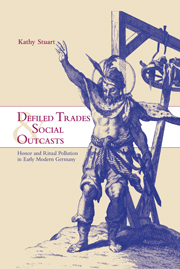Book contents
- Frontmatter
- Contents
- List of illustrations
- Acknowledgments
- List of abbreviations
- Glossary
- Introduction: defiled trades
- PART I THE MEANING OF DISHONOR IN EARLY MODERN SOCIETY
- PART II THE DISHONORABLE MILIEU
- PART III PARADOXICAL DISHONOR: PUNISHMENT AND HEALING
- PART IV ARTISANAL HONOR AND URBAN POLITICS
- Conclusion: dishonor and the society of orders
- Selected bibliography
- Index
- CAMBRIDGE STUDIES IN EARLY MODERN HISTORY
Conclusion: dishonor and the society of orders
Published online by Cambridge University Press: 06 August 2009
- Frontmatter
- Contents
- List of illustrations
- Acknowledgments
- List of abbreviations
- Glossary
- Introduction: defiled trades
- PART I THE MEANING OF DISHONOR IN EARLY MODERN SOCIETY
- PART II THE DISHONORABLE MILIEU
- PART III PARADOXICAL DISHONOR: PUNISHMENT AND HEALING
- PART IV ARTISANAL HONOR AND URBAN POLITICS
- Conclusion: dishonor and the society of orders
- Selected bibliography
- Index
- CAMBRIDGE STUDIES IN EARLY MODERN HISTORY
Summary
Executioners and skinners and their families, the core group of dishonorable people, occupied a symbolic position as outsiders in early modern German society. Jurists classified them as infamous and listed a multitude of legal, social, and religious disabilities that derived from their dishonor: the executioner or skinner lived “like a wild animal,… excluded from the community of honorable people.” These legal scholars vastly exaggerated the discrimination executioners and skinners suffered in social practice, however. Executioners and skinners were not absolute pariahs. In Augsburg the city government did deny executioners and skinners citizenship, but the patrician magistrates did not discriminate against them in any other way. Honorable guildsmen, the lowest honorable estate in the corporate hierarchy within the city, were the social group that most adamantly enforced the social exclusion of dishonorable people. From the early sixteenth century on, no honorable guild incorporated a member of the dishonorable core group. Artisans were also most concerned about the danger of ritual pollution by social or physical contact with the executioner or skinner.
The exclusion from honorable guilds most likely had little practical impact on executioners and skinners in the later sixteenth and seventeenth centuries, since they had little reason to want to join an artisan guild. Executioners and skinners were strongly stigmatized, but a social abyss separated them from criminals and the disreputable vagrant poor who were executed or made infamous at their hands.
- Type
- Chapter
- Information
- Defiled Trades and Social OutcastsHonor and Ritual Pollution in Early Modern Germany, pp. 253 - 260Publisher: Cambridge University PressPrint publication year: 2000

